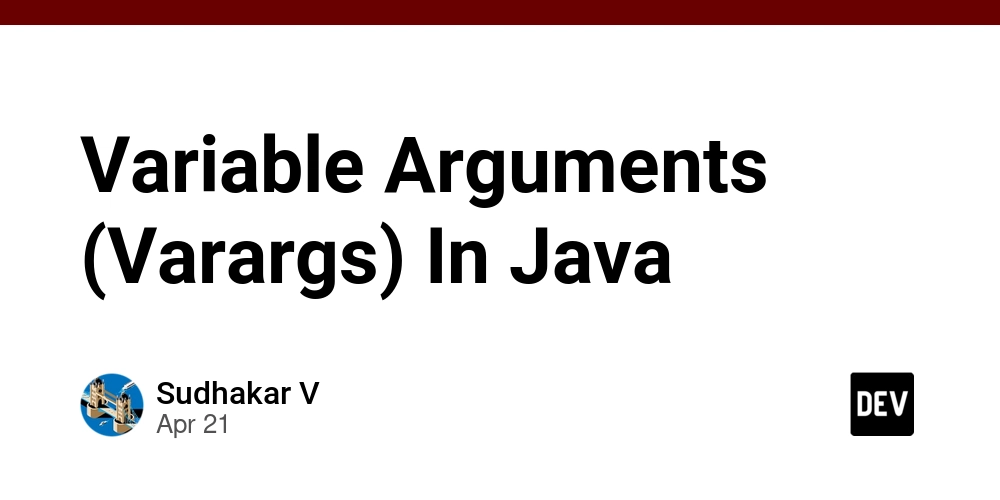Variable Arguments (Varargs) In Java
Variable Arguments (Varargs) in Java is a method that takes a variable number of arguments. Variable Arguments in Java simplify the creation of methods that need to take a variable number of arguments. Example: We will see the demonstration of using Varargs in Java to pass a variable number of arguments to a method. import java.io.*; class Geeks { // Method that accepts variable number // of String arguments using varargs public static void Names(String... n) { // Iterate through the array // and print each name for (String i : n) { System.out.print(i + " "); } System.out.println(); } public static void main(String[] args) { // Calling the 'Names' method with // different number of arguments Names("geek1", "geek2"); Names("geek1", "geek2", "geek3"); } } Output geek1 geek2 geek1 geek2 geek3 Explanation: In the above example, the String… names allows the method to accept a variable number of String arguments. Inside the method, the for-each loop iterates over the names array and prints each name. The method is called twice in main(), with two and three arguments respectively. Syntax of Varargs Internally, the Varargs method is implemented by using the single dimensions arrays concept. Hence, in the Varargs method, we can differentiate arguments by using Index. A variable-length argument is specified by three periods or dots(…). public static void fun(int … a) { // method body } This syntax tells the compiler that fun( ) can be called with zero or more arguments. As a result, here, a is implicitly declared as an array of type int[]. Need of Java Varargs Until JDK 4, we cant declare a method with variable no. of arguments. If there is any change in the number of arguments, we have to declare a new method. This approach increases the length of the code and reduces readability. Before JDK 5, variable-length arguments could be handled in two ways. One uses an overloaded method(one for each). Another puts the arguments into an array and then passes this array to the method. Both of them are potentially error-prone and require more code. To resolve these problems, Variable Arguments (Varargs) were introduced in JDK 5. From JDK 5 onwards, we can declare a method with a variable number of arguments. Such types of methods are called Varargs methods. The varargs feature offers a simpler, better option. Example 1: Varargs with Integer Arguments class Test1 { // A method that takes variable // number of integer arguments. static void fun(int... a) { System.out.println("Number of arguments: " + a.length); // using for each loop to display contents of a for (int i : a) System.out.print(i + " "); System.out.println(); } // Driver code public static void main(String args[]) { // Calling the varargs method with // one parameter fun(100); // four parameters fun(1, 2, 3, 4); // no parameter fun(); } } Output Number of arguments: 1 100 Number of arguments: 4 1 2 3 4 Number of arguments: 0 Explanation: In the above example, the fun(int… a) method accepts a variable number of integers. The length of the arguments is accessed using a.length. A for-each loop is used to iterate over the arguments and print each value. Note: A method can have variable length parameters with other parameters too, but one should ensure that there exists only one varargs parameter that should be written last in the parameter list of the method declaration. For example: int nums(int a, float b, double … c) In this case, the first two arguments are matched with the first two parameters, and the remaining arguments belong to c. Example 2: Varargs with Other Arguments // varargs with normal arguments class Test2 { // Takes string as a argument // followed by varargs static void fun2(String s, int... a) { System.out.println("String: " + s); System.out.println("Number of arguments is: " + a.length); // using for each loop to // display contents of a for (int i : a) System.out.print(i + " "); System.out.println(); } public static void main(String args[]) { // Calling fun2() with different parameter fun2("GeeksforGeeks", 100, 200); fun2("CSPortal", 1, 2, 3, 4, 5); fun2("forGeeks"); } } Output String: GeeksforGeeks Number of arguments is: 2 100 200 String: CSPortal Number of arguments is: 5 1 2 3 4 5 String: forGeeks Number of arguments is: 0 Erroneous Varargs Examples Case 1: Specifying two Varargs in a single method: void method(String… gfg, int… q) { // Compile time error as there // are two varargs } Case 2: Specifying Varargs as the first parameter of the method instead of the last one: void method(int… gfg, String q) { // Compile time error as vararg // appear before normal argument } Important Points Vararg Methods can also be overlo

Variable Arguments (Varargs) in Java is a method that takes a variable number of arguments. Variable Arguments in Java simplify the creation of methods that need to take a variable number of arguments.
Example: We will see the demonstration of using Varargs in Java to pass a variable number of arguments to a method.
import java.io.*;
class Geeks {
// Method that accepts variable number
// of String arguments using varargs
public static void Names(String... n) {
// Iterate through the array
// and print each name
for (String i : n) {
System.out.print(i + " ");
}
System.out.println();
}
public static void main(String[] args) {
// Calling the 'Names' method with
// different number of arguments
Names("geek1", "geek2");
Names("geek1", "geek2", "geek3");
}
}
Output
geek1 geek2
geek1 geek2 geek3
Explanation: In the above example, the String… names allows the method to accept a variable number of String arguments. Inside the method, the for-each loop iterates over the names array and prints each name. The method is called twice in main(), with two and three arguments respectively.
Syntax of Varargs
Internally, the Varargs method is implemented by using the single dimensions arrays concept. Hence, in the Varargs method, we can differentiate arguments by using Index. A variable-length argument is specified by three periods or dots(…).
public static void fun(int … a)
{
// method body
}
This syntax tells the compiler that fun( ) can be called with zero or more arguments. As a result, here, a is implicitly declared as an array of type int[].
Need of Java Varargs
Until JDK 4, we cant declare a method with variable no. of arguments. If there is any change in the number of arguments, we have to declare a new method. This approach increases the length of the code and reduces readability.
Before JDK 5, variable-length arguments could be handled in two ways.
One uses an overloaded method(one for each).
Another puts the arguments into an array and then passes this array to the method. Both of them are potentially error-prone and require more code.
To resolve these problems, Variable Arguments (Varargs) were introduced in JDK 5. From JDK 5 onwards, we can declare a method with a variable number of arguments. Such types of methods are called Varargs methods. The varargs feature offers a simpler, better option.
Example 1: Varargs with Integer Arguments
class Test1 {
// A method that takes variable
// number of integer arguments.
static void fun(int... a)
{
System.out.println("Number of arguments: "
+ a.length);
// using for each loop to display contents of a
for (int i : a)
System.out.print(i + " ");
System.out.println();
}
// Driver code
public static void main(String args[])
{
// Calling the varargs method with
// one parameter
fun(100);
// four parameters
fun(1, 2, 3, 4);
// no parameter
fun();
}
}
Output
Number of arguments: 1
100
Number of arguments: 4
1 2 3 4
Number of arguments: 0
Explanation: In the above example, the fun(int… a) method accepts a variable number of integers. The length of the arguments is accessed using a.length. A for-each loop is used to iterate over the arguments and print each value.
Note: A method can have variable length parameters with other parameters too, but one should ensure that there exists only one varargs parameter that should be written last in the parameter list of the method declaration. For example:
int nums(int a, float b, double … c)
In this case, the first two arguments are matched with the first two parameters, and the remaining arguments belong to c.
Example 2: Varargs with Other Arguments
// varargs with normal arguments
class Test2 {
// Takes string as a argument
// followed by varargs
static void fun2(String s, int... a) {
System.out.println("String: " + s);
System.out.println("Number of arguments is: "
+ a.length);
// using for each loop to
// display contents of a
for (int i : a)
System.out.print(i + " ");
System.out.println();
}
public static void main(String args[])
{
// Calling fun2() with different parameter
fun2("GeeksforGeeks", 100, 200);
fun2("CSPortal", 1, 2, 3, 4, 5);
fun2("forGeeks");
}
}
Output
String: GeeksforGeeks
Number of arguments is: 2
100 200
String: CSPortal
Number of arguments is: 5
1 2 3 4 5
String: forGeeks
Number of arguments is: 0
Erroneous Varargs Examples
Case 1: Specifying two Varargs in a single method:
void method(String… gfg, int… q)
{
// Compile time error as there
// are two varargs
}
Case 2: Specifying Varargs as the first parameter of the method instead of the last one:
void method(int… gfg, String q)
{
// Compile time error as vararg
// appear before normal argument
}
Important Points
Vararg Methods can also be overloaded, but overloading may lead to ambiguity.
Before JDK 5, variable length arguments could be handled in two ways: One was using overloading, other was using array argument.
There can be only one variable argument in a method.
Variable argument (Varargs) must be the last argument.


















_Tanapong_Sungkaew_via_Alamy.jpg?width=1280&auto=webp&quality=80&disable=upscale#)
















































